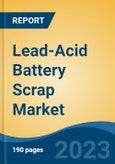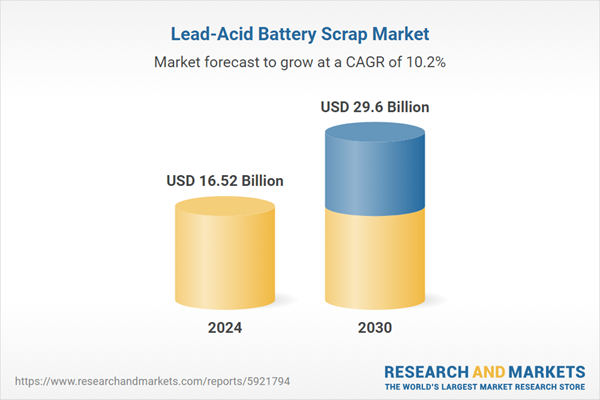Motor Vehicles is the fastest growing segment, Asia-Pacific is the largest regional market
Speak directly to the analyst to clarify any post sales queries you may have.
10% Free customizationThis report comes with 10% free customization, enabling you to add data that meets your specific business needs.
Key Market Drivers
The Global Lead-Acid Battery Scrap Market is significantly propelled by two primary factors: increased environmental regulations and sustainability mandates, alongside the high economic value and recyclability of lead. Heightened governmental and industry-specific regulations globally enforce responsible disposal and recycling practices for lead-acid batteries, thereby stimulating the scrap market. This regulatory pressure ensures a consistent flow of end-of-life batteries into the recycling stream. For example, according to Battery Council International's National Recycling Rate Study, released in July 2023, the U. S. lead battery industry achieved an outstanding recycling rate of 99%, the highest of any consumer product in the United States, largely sustained by its robust closed-loop system.Key Market Challenges
A significant challenge impeding the growth of the Global Lead-Acid Battery Scrap Market is the considerable capital expenditure required for establishing and maintaining advanced recycling facilities. This financial barrier directly restricts investment in state-of-the-art processing technologies and robust collection infrastructure. Such substantial upfront costs deter potential new market entrants and slow the expansion plans of existing recycling operations. Consequently, the ability to scale up efficient and environmentally compliant lead-acid battery recycling capacity worldwide is constrained.According to the International Lead and Zinc Study Group, global refined lead production was forecast to increase by 2.7% to 12.8 million tons in 2023, with consumption also projected to rise by 1.1% to 12.8 million tons. This modest growth in production, despite ongoing demand, underscores the impact of high investment costs in limiting the development of new recycling plants and upgrading existing ones to meet stringent environmental standards and increasing volumes of end-of-life batteries. This sustained requirement for substantial capital outlays slows the overall development of a comprehensive and efficient global recycling ecosystem.
Key Market Trends
The adoption of advanced recycling technologies represents a pivotal trend enhancing material recovery and environmental performance. These innovations move beyond conventional methods to extract valuable components with greater precision and reduced ecological impact. According to the European Commission's Batteries Regulation, which became effective in 2023, ambitious recycling efficiency targets for lead-acid batteries are set at 75% by December 2025 and 80% by December 2030, necessitating continuous technological upgrades to meet these benchmarks. The industry continues to pursue new techniques for processing battery scrap, minimizing waste, and improving the purity of recovered lead and other materials.Key Market Players Profiled:
- Johnson Controls International PLC
- Exide Technologies S.A.S.
- East Penn Manufacturing Co., Inc.
- GS Yuasa International Ltd.
- Battery Solutions LLC
- Whitelake Organics Pvt Ltd.
- Gravita India Ltd.
- Aqua Metals Inc.
- Madenat Al Nokhba Recycling Services LLC
- Beeah Group
Report Scope:
In this report, the Global Lead-Acid Battery Scrap Market has been segmented into the following categories:By Battery:
- Flooded
- Sealed
By Product:
- Lead
- Sulfuric acid
By Source:
- Motor Vehicles
- UPS
By Region:
- North America
- Europe
- Asia-Pacific
- South America
- Middle East & Africa
Competitive Landscape
Company Profiles: Detailed analysis of the major companies present in the Global Lead-Acid Battery Scrap Market.Available Customizations:
With the given market data, the publisher offers customizations according to a company's specific needs. The following customization options are available for the report.Company Information
- Detailed analysis and profiling of additional market players (up to five).
This product will be delivered within 1-3 business days.
Table of Contents
Companies Mentioned
The companies profiled in this Lead-Acid Battery Scrap market report include:- Johnson Controls International PLC
- Exide Technologies S.A.S.
- East Penn Manufacturing Co., Inc.
- GS Yuasa International Ltd.
- Battery Solutions LLC
- Whitelake Organics Pvt Ltd.
- Gravita India Ltd.
- Aqua Metals Inc.
- Madenat Al Nokhba Recycling Services LLC
- Beeah Group
Table Information
| Report Attribute | Details |
|---|---|
| No. of Pages | 181 |
| Published | November 2025 |
| Forecast Period | 2024 - 2030 |
| Estimated Market Value ( USD | $ 16.52 Billion |
| Forecasted Market Value ( USD | $ 29.6 Billion |
| Compound Annual Growth Rate | 10.2% |
| Regions Covered | Global |
| No. of Companies Mentioned | 11 |









